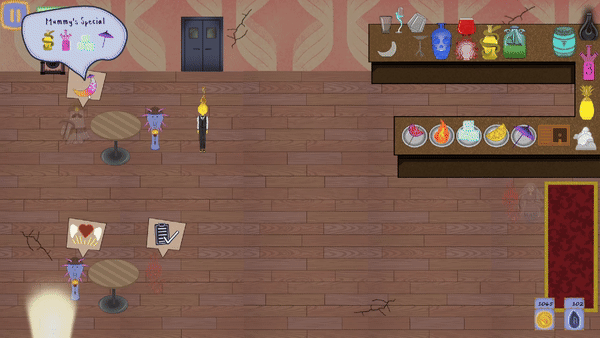Dusk Diener
In the summer between my second and third year at university, I made a game with four other students over two months as part of a local studio called Octopus 8.
Our game, titled Dusk Diener, focused on being a bartender for spirits who weren't yet ready to visit the afterlife. You had to serve them various fantastical drinks until they felt satisfied enough to pass on.
I was the lead designer for the game, and my role included the following:
Using Trello to track which tasks I had to complete by when and inform my team of my progress.
Numerically designing the game so we knew how long each level would take on average and consequently how long the game would take to complete, as it had to be an hour or under.
Crafting the game progression through purchasable upgrades, meaning the game would only become more challenging once the player feels comfortable enough to buy more ingredients or an upgrade that increases customer frequency, for example.

Working on Dusk Diener as the lead designer helped me improve myself and made me feel more prepared for my final year. Some of the ways the project helped me were:
It helped with understanding how to communicate my ideas to the team concisely, along with taking team members' ideas and suggestions on board.
It helped me understand the importance of having clear documentation that other members can refer to whenever necessary.
The project gave me the opportunity to identify where I can best help the team and adapt to the current circumstances. Instead of solely designing the game, I recognised that I could assist in programming, alleviating some of the pressure from the programmer and helping us reach our milestones more effectively.
The Story of Dusk Diener

We decided that postcards arriving at the diner would be the best way to communicate the game's story. As the protagonist cannot recall their identity, the postcards gradually help them remember and prepare them to pass into the afterlife.
The player also receives postcards from visitors, called Relics. They represent a crucial memory of that visitor, and the protagonist comments upon it. You can see the relics on the right, along with the comments that the protagonist makes about visitors' stories.
Upgrades in the game
All upgrades reward the player, with some also making the game harder. Buying extra tables means the player can serve more customers at once and so earn more money, but increases the difficulty due to there being more visitors to satisfy.


Calculating the Length of the Game
Something that proved invaluable when designing was knowing the game's expected duration, as the project required the game to last under an hour.
With such information, I could calculate how many days the player will play through, how long each day will last, and at what frequency they should get the postcards that communicate the game's story.
The spreadsheet screenshot below shows the numbers I used to calculate the game's length.

A Video of Dusk Diener
The below video demonstrates the numbers in the above spreadsheet. In the night seen in the video, the player managed to serve 10 drinks and take 4 customers to the afterlife. The above spreadsheet says that the average player should be able to serve 5 - 11 drinks per night and send 3 - 6 customers to the afterlife per night.
The accuracy of the calculations allowed me to understand what numbers we would need increase or decrease the game's pace.
If you click off of the game and cannot click back on it, please refresh the page.
Credits
The art seen on this page belongs to the two artists who were part of our team on the project, Renata Sliozyte (Portfolio: https://renatasliozyte.wixsite.com/renata-sliozyte) and Cerise Chu (Portfolio https://cerisechu.wixsite.com/home).